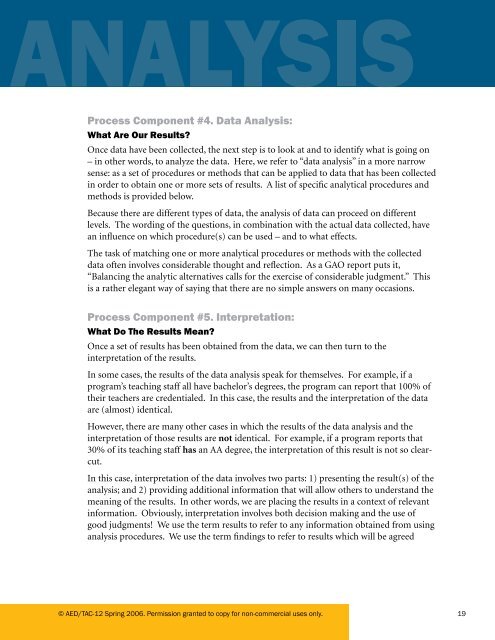Introduction to Data Analysis Handbook - AED Center for Early Care ...
Introduction to Data Analysis Handbook - AED Center for Early Care ...
Introduction to Data Analysis Handbook - AED Center for Early Care ...
Create successful ePaper yourself
Turn your PDF publications into a flip-book with our unique Google optimized e-Paper software.
Process Component #4. <strong>Data</strong> <strong>Analysis</strong>:<br />
What Are Our Results?<br />
once data have been collected, the next step is <strong>to</strong> look at and <strong>to</strong> identify what is going on<br />
– in other words, <strong>to</strong> analyze the data. Here, we refer <strong>to</strong> “data analysis” in a more narrow<br />
sense: as a set of procedures or methods that can be applied <strong>to</strong> data that has been collected<br />
in order <strong>to</strong> obtain one or more sets of results. A list of specific analytical procedures and<br />
methods is provided below.<br />
Because there are different types of data, the analysis of data can proceed on different<br />
levels. The wording of the questions, in combination with the actual data collected, have<br />
an influence on which procedure(s) can be used – and <strong>to</strong> what effects.<br />
The task of matching one or more analytical procedures or methods with the collected<br />
data often involves considerable thought and reflection. As a GAo report puts it,<br />
“Balancing the analytic alternatives calls <strong>for</strong> the exercise of considerable judgment.” This<br />
is a rather elegant way of saying that there are no simple answers on many occasions.<br />
Process Component #5. Interpretation:<br />
What Do The Results Mean?<br />
once a set of results has been obtained from the data, we can then turn <strong>to</strong> the<br />
interpretation of the results.<br />
in some cases, the results of the data analysis speak <strong>for</strong> themselves. For example, if a<br />
program’s teaching staff all have bachelor’s degrees, the program can report that 100% of<br />
their teachers are credentialed. in this case, the results and the interpretation of the data<br />
are (almost) identical.<br />
However, there are many other cases in which the results of the data analysis and the<br />
interpretation of those results are not identical. For example, if a program reports that<br />
30% of its teaching staff has an AA degree, the interpretation of this result is not so clearcut.<br />
in this case, interpretation of the data involves two parts: 1) presenting the result(s) of the<br />
analysis; and 2) providing additional in<strong>for</strong>mation that will allow others <strong>to</strong> understand the<br />
meaning of the results. in other words, we are placing the results in a context of relevant<br />
in<strong>for</strong>mation. obviously, interpretation involves both decision making and the use of<br />
good judgments! We use the term results <strong>to</strong> refer <strong>to</strong> any in<strong>for</strong>mation obtained from using<br />
analysis procedures. We use the term findings <strong>to</strong> refer <strong>to</strong> results which will be agreed<br />
© <strong>AED</strong>/TAC-12 Spring 2006. Permission granted <strong>to</strong> copy <strong>for</strong> non-commercial uses only.<br />
1



